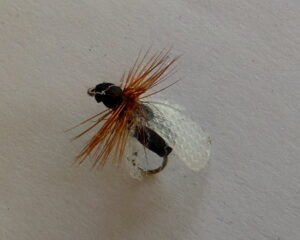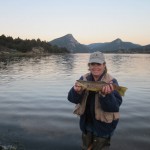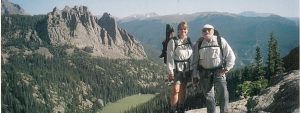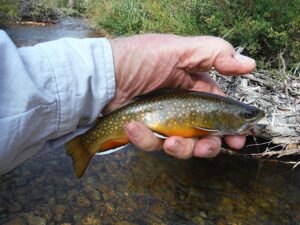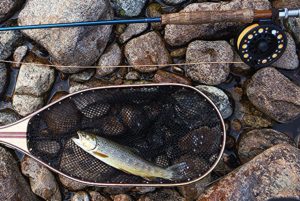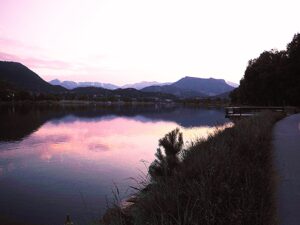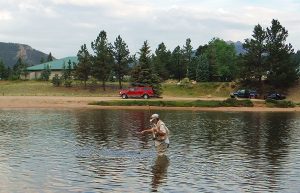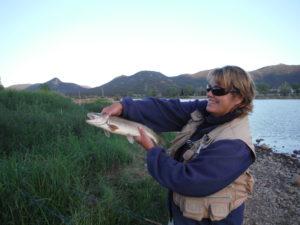Fishing blog: Tales of angling adventures from around the world
Welcome to our fish blog! Here you can read more sage advice from anglers around the world. This is the place for news, tips and non-fiction fish tales from mountain lakes to distant beaches. Please feel free to comment and join in on the conversations and share some fish tales of your own!
Yesterday, I fished The Loch in Rocky Mountain National Park. Due to the issue of limited parking, I arrived at the Glacier Gorge parking lot at 6:30 AM and to my surprise found a parking space! It was a beautiful, cloudless blue-sky day. The only issue I encountered, weather-wise, was strong gusty winds all day. The wind was blowing from the southwest straight into all directions for casting a fly. There were a lot of big snow drifts at the lake which required going up and around or climbing over the smaller ones.
Fishing was really slow! I saw maybe 5 fish all day, hooked one with an early release, had refusals several times and one fish in the inlet stream seemed to be blind. He went for my fly a half a dozen times, missed each time and finally gave up. I tried many different flies including a prince nymph, beaded pink San Juan worm, flying ant and parachute ant, but the one that I finally hooked a fish on was my go-to fly, a parachute Adams.
Besides being almost blown off into the ice-cold water while fishing off the big rock on the west shore, the main bummer of the day was breaking my fly rod. Thankfully it happened near the end of the day. The knot that connects the leader to the fly line hooked on one of the eyes as I was pulling the fly line out so that I could change out the leader. I tried fixing it with a stick wrapped on with tippet line. That didn’t work very well and instead of a straight rod it was kind of bent! Ha! I’m thankful that it wasn’t an expensive Sage rod!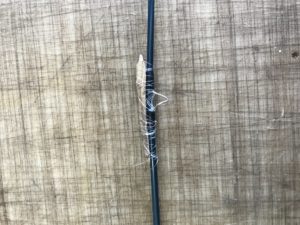
That ended fishing for the day. I walked the trail back by Alberta Falls just to see the tremendous amount of water cascading over the falls as all of this snow melts.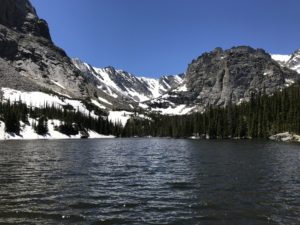
Last Fall I fished the Big Thompson River around the Fern Lake Trailhead for a couple of hours. Although the area around the Cub Lake Trailhead was crowded with guided trips there were no other anglers on the river upstream. The water was low now so crossing the river was not a problem. The brook trout and browns were actively feeding as the temperatures cool and the leaves turn. All fish caught and released using a flying ant pattern. Keep this as an option when the water levels cooperate.
This season’s snow pack promises plenty of water this summer. That is good news for folks needing irrigation water but not so much for anglers eagerly anticipating sunny days fishing in the high lakes in Rocky Mountain National Park. It’s a convenient coincidence that this lack of easy access comes when many of us are not at the peak of conditioning, even after a winter spent aerobically tying flies.
The streams and lakes in Estes Park at the “lower” elevations from 8500’ down were fishing great before the run-off came our way. Take advantage of this early season access near Lake Estes by fishing the Big Thompson River where it enters the lake by the 9-hole golf course. The trick is to fish early in the day before the runoff from a warm day melts the snow in RMNP and brings turbid water our way.
Or you can follow the trail to the west, across the bridge, to where the power plant might be running and creates a second inlet with warmer water. The discharge here is usually clear after the trip from Grand Lake through the Adam’s tunnel. When the power plant turbines are running, the area between the power plant and the lake is productive.
Below the lake, the Olympus Dam controls the flow down the Big Thompson Canyon. This popular stretch of accessible water is strictly artificial lures/catch and release from the dam downstream 8 miles to Waltonia Bridge. The settling and warming effect of Lake Estes plus the scouring this river bed has received recently keep sediment and turbidity to a minimum. The downside of this stretch is the popularity. Estes Guide services use this area heavily but only during “regular” hours. The trick right below the dam is to either fish it as the sun rises or after it sets. Go there when most folks are standing in lines at local restaurants and you will be rewarded.
We love to fish dry flies and rarely use nymphs. That being said, this is a great time of year to drift a bead head-flash back-pheasant tail nymph down the stream. In the evening, we mostly use a floating flying ant pattern. The ones with cellophane wings will reflect sunlight and flash in the setting sun. This fly must resemble a lot of different insects since its accepted most of the year. A dead drift is always a good presentation, but we find a short “skitter” and stop seems to get attention from the big lazy browns. It also helps us locate the fly when it’s getting dark and we just have to watch for the rise form.